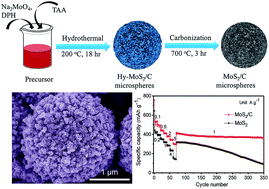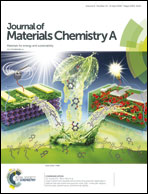Hierarchical MoS2/Carbon microspheres as long-life and high-rate anodes for sodium-ion batteries†
Abstract
Sodium-ion batteries (SIBs) are considered promising low-cost alternatives to prevailing lithium-ion batteries (LIBs). The inherently sluggish kinetics of their anode materials, however, poses a great challenge to the SIBs' rate capabilities. This work reports the synthesis of novel MoS2/Carbon (MoS2/C) microspheres with three-dimensional (3D) architecture as an anode for SIBs using a facile hydrothermal strategy. The MoS2/C electrode delivers a reversible capacity of 498 mA h g−1 at 100 mA g−1, which stabilizes at 450 mA h g−1 after 100 cycles. Even at 4 A g−1, the electrode maintains a high reversible capacity above 310 mA h g−1 after 600 cycles, demonstrating its superior rate capability and long-term cyclic stability. Quantitative kinetics analysis reveals a pseudocapacitance-dominated Na+ storage mechanism, especially at high current densities. Furthermore, density functional theory (DFT) calculations show that the Na transport rates are faster through the MoS2/C heterointerface, due to a low diffusion energy barrier, than along the MoS2/MoS2 bilayers.



 Please wait while we load your content...
Please wait while we load your content...